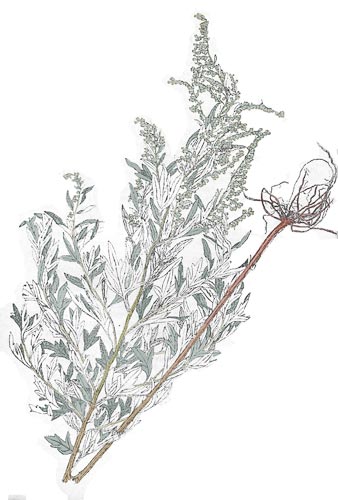Weeds
Artemisia argyi Levl. et Vaniot -Argyi Wormwood.
Taxonomic position.
Family Asteraceae (Compositae), genus Artemisia L.Biological group.
Perennial rhizome plant.Morphology and biology.
Plant has a thin strong creeping rhizome to 20 cm in length. Stalks are upright, single, gray tomentose, 75 to 120 cm tall, with short branches. Leaves are petiolar, ovate, deep partite, with dotty glands, pubescent from above and densely white-tomentose from below. Average leaves are 5-7 cm long and 3-5 cm wide. Leaf lobes are connivent, dulled, wide-lanceolate, with short denticles along margins. Upper leaves are small, three-partite. Bracteal leaves are simple, linear-lanceolate. Inflorescence is narrow and paniculate. Calathidia heads are campaniform, 2.5-4 mm long and 1.5-3 mm wide, sessile or located on short pedicels. Central flowers are bisexual, marginal flowers are feminine. Petals are threadlike-tubular. Corolla is narrowly-campaniform and conic. Involucre leaflets are cobwebby pubescent. Hemicarps are obovate, 1.2-1.5 mm long, light-brown, dim. 2n=36.Distribution.
General distribution includes Japan and China. The species is described to be from China. In the territory of the former USSR it occurs in the south of the Far East, i.e., in Primorskii Territory and Amur Region (Ussuri, Nizhnyaya Zeya, and Bureya districts). Now the species is found occasionally in other regions (Krasnoyarsk, Kozelsk, Moldova, and others) as an adventive plant.Ecology.
Plant grows on dry mountain slopes and along high river banks, on oak forest edges, less often on inundated meadows and in coastal bushes. It is the most xerophilous species among the Far-Eastern wormwoods.Economic significance.
Plant contains ester oil. Grass tincture is used in folk medicine. In anthropogenic landscapes the weed frequently grows on fallow lands and in garbage sites, and along roads and railways. It is seldom found in crops (grain, soy), and then only in smaller quantities. Control measures include regular destruction of wormwood rhizomes with appropriate types of soil treatment and herbicides; avoiding contamination of sowing material or ground by seeds; mowing-off or pulling up the weed before fructification.Reference citations:
Kharkevitch S.S., ed. 1992. Vascular plants of the Soviet Far East. V. 6. Saint Petersburg: Nauka. 428 pp. (in Russian).Nikitin V.V. 1983. Weed plants of the USSR flora. Leningrad: Nauka. 454 pp. (in Russian).


